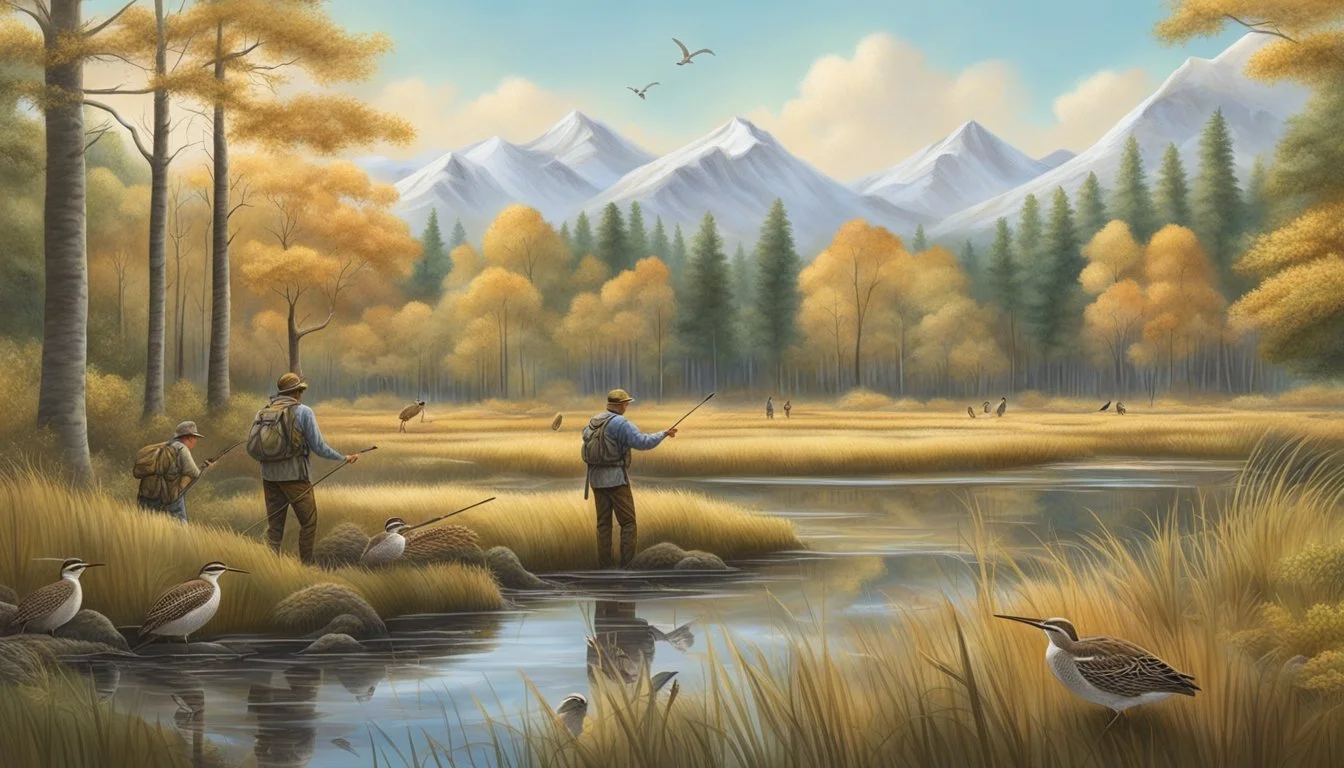Snipe Hunting for Beginners
Essential Tips for First-Time Hunters
Snipe hunting is a pastime that blends outdoor skill with tradition, offering a unique challenge to both seasoned hunters and those new to the sport. Snipes are well-known for their elusive nature, making the hunt particularly satisfying. These birds are waders, belonging to the Scolopacidae family, characterized by their long, slender beaks and camouflaged plumage. The pursuit of snipes is recognized legally and seasonally, with specific guidelines governing the activity to ensure sustainable hunting practices.
For beginners, hunting these birds can serve as a fun introduction to the world of bird hunting. It provides an opportunity to learn about habitat, behavior, and hunting ethics in the field. The experience teaches stealth and patience, as these birds are typically found in marshy areas where quiet, careful movement is vital. Furthermore, hunters are often introduced to gun safety and proper shooting techniques, as snagging a swift-moving snipe requires precision and control. The social aspect of snipe hunting, with traditions of camaraderie among friends and sharing a joke, also contributes to its appeal among hunters.
In the 1840s, a 'snipe hunt' became a practical joke, fool's errand, or wild goose chase that was played on the unsuspecting. For fun a newcomer was duped into trying to catch snipe in dark woods at night with a full moon by making noises. This was an elusive, nonexistent bird that looked like a cross between a rabbit and a squirrel-like bird. As an American tradition, snipe hunting is still often associated with a summer camp prank at night or practical jokes, for example with the Boy Scouts for a bit of fun.
Understanding Snipe and Their Habitat
Understanding the snipe's habitat and behavior is crucial for stalkers looking to engage in a waterfowl hunt, a challenging and rewarding form of waterfowl hunting.
The Snipe: A Game Bird Overview
The snipe is a member of the family Scolopacidae, which is a diverse group of wading birds. Common snipe and Wilson's snipe are two closely related species often encountered during hunting snipe and are sometimes referred to interchangeably due to their similarities.
Identifying Snipe Habitats
Snipe habitat is characterized by its wet and marshy nature. These birds thrive in environments with:
Wetlands and marshes: Areas with abundant water where snipes can easily forage.
Mud and soft soil: Essential for their probing behavior as they search for food.
Dark soiled areas: Often found in places with richer, darker soil.
Cow pastures and drainage ditches: Atypical but viable habitats where snipe can be spotted.
Tables and covers are integral for snipe protection and are common within these environments.
Snipe Behavior and Characteristics
Snipes display erratic flight patterns making them elusive targets for stalkers. The bird is well adapted to its environment with plumage that helps it blend into mud, sandpipers, and flag ponds. When identifying snipe, look for:
Plumage: They possess more brown and black colors, with minimal white, to camouflage into their environment.
Flight pattern: When they fly they are less predictable, which can create fun for stalkers.
Snipe, along with other game birds such as killdeer, American woodcock, and dowitcher, need to be handled with care
Preparing for the Hunt
Before embarking on a successful snipe hunt, beginners need to focus on gathering the right equipment, choosing suitable attire, scouting the area for hunting snipe to get a good catch, and understanding safety and legal considerations.
Essential Hunting Gear
To successfully hunt snipe, one requires specific gear that's both efficient and reliable. A shotgun is the primary tool for the hunt—typically a light 12-gauge or 20-gauge with appropriate birdshot sizes (7 1/2, 8, or 9). Stalkers should ensure their shotgun skills are honed before the hunt to increase their chances of success on the shoot. Alongside the gun, stalkers need a sturdy bird vest or game vest to carry ammunition and hold any catch.
Clothing and Attire
The attire chosen for a snipe hunt is a critical factor in both comfort and effectiveness. Waterproof boots or rubber boots are essential, as the terrain can be wet and muddy. Waders may also be beneficial for those stalking through marshy areas. Camouflage clothing helps the stalker blend in with the surroundings, and durable, water-resistant pants are advisable to combat the often damp environs.
Suggested Attire:
Waterproof or rubber boots
Waders for marshy areas
Camouflage clothing
Water-resistant pants
Planning and Scouting
Thorough planning and scouting before the hunt are imperative for a productive hunt. Stalkers must familiarize themselves with the habitat snipes are likely to be found in—typically marshes, muddy fields, and wetlands. Planning should also include understanding the bird's behavior patterns. Scouting the area before the hunt allows the stalker to identify signs of snipe presence and to strategize points for stalking and flushing the birds waiting to be caught.
Safety Measures and Legal Compliance
Snipe hunting must be conducted with a high regard for safety and adherence to local hunting regulations. Stalkers need to be aware of the laws governing hunting seasons, bag limits, and required licenses. Wearing blaze orange is often necessary to maintain visibility to other stalkers. Additionally, responsible hunting practices ensure both the safety of the stalker and the sustainability of the wildlife populations.
Safety Checklist:
Be aware of the point of local snipe hunt regulations
Complete required stalker safety courses
Wear blaze orange where applicable
Practice responsible use of firearms
Hunting Strategies and Techniques
A successful snipe hunting requires understanding this bird's elusive nature and employing strategic techniques to attract it. Stalkers often adapt to the bird's habits, favored terrain, and reaction to human presence.
Hunting Techniques
Stalking: Stalkers need to move stealthily through marsh and wetland habitats, as on a snipe hunt the bird is adept at hiding in muddy areas with vegetation. The point of moving quietly is to prevent flushing the game prematurely.
Flushing: The act of walking through potential habitats can cause the game to flush into the air, giving the advantage of making them visible for a shot. Stalkers use a zigzag walk pattern to cover more ground and increase their chances of encountering snipes.
Effective Shot Placement: Given the snipe's erratic flight pattern, it's crucial to anticipate its movements and aim ahead of its flight path for the kill. Precision is key, and typically 12 or 20 gauge shotguns loaded with appropriate shells are chosen, with smaller gauges in the course of sportier hunts.
Effective Use of Hunting Dogs
Dog Selection: Using hunting dogs can greatly enhance the snipe hunting experience when they act as scouts. Breeds like spaniels and pointers are a well-suited animal for wetlands and have the instinctual abilities to locate and flush out game without making noises.
Training for Optimized Hunting: Dogs must be trained to harness their natural instincts to work with stalkers. These kinds of animal respond to commands, search for cover effectively without straying too far, and remain steady during shots. The point of the dog's role in retrieving the downed snipe is also crucial, minimizing the hunter's disturbance of the environment and maximizing efficiency.
Seasons and Conservation
In the realm of snipe hunting, understanding the timing of seasons and adhering to conservation practices are pivotal for the sport's sustainability. Stalkers must familiarize themselves with specific hunting seasons and bag limits, which are established to maintain healthy snipe populations.
Understanding Snipe Seasons
Snipe hunting seasons are determined largely by the bird's migratory patterns. Fall typically marks the beginning of the snipe hunting season, and it can vary from region to region.
Alabama: The season runs from November 11th through February 25th.
General Trend: Many areas observe snipe seasons in the cooler months, which can start in early fall and extend into late winter.
Stalkers need to check with local wildlife departments to confirm exact dates, as snipe hunting is regulated and may change yearly based on ecological surveys and population health data.
Conservation and Bag Limits
Conservation efforts for migratory game, including snipe, involve establishing bag limits—the maximum number of birds a hunter can legally harvest in a day.
Alabama Example: For the lucky stalkers are allowed to harvest up to 8 birds per day.
Conservation Purpose: These limits help ensure that catching snipe does not adversely affect snipe populations.
Regulations and bag limits are a reflection of ongoing wildlife management and conservation strategies. They balance the needs of the stalkers with the preservation of species to ensure that snipe stalking remains a sustainable practice for future generations. Stalkers must always comply with these regulations for the well-being of the ecosystem and the sport of bird stalking.
Engaging with the Snipe Hunting Community
New snipe stalkers often find that becoming part of the snipe hunting community enriches their experience and deepens their appreciation for this unique sport. The community offers a wealth of knowledge, from seasoned stalkers who have turned snipe stalking into a passionate obsession to those who regard it as a meaningful rite of passage within the hunting tradition.
Sharing Experiences
Snipe stalkers seek each other out in groups to exchange tales of their hunting endeavors. These narratives are more than just stories in the group; they're an exchange of valuable insights on effective strategies and observations in the field. Through discussion, a beginner can quickly learn about:
Best Practices: Expert stalkers share time-tested techniques that can drastically improve a novice's hunting success, such as using a lure and bird dogs.
Local Regulations: Understanding the law is crucial. Peers in the community assist new stalkers in navigating the complex legal aspects of stalking snipe.
Conservation Efforts: Stalkers discuss the importance of sustainable practices for hunted snipe to ensure that the tradition can carry on for future generations.
This dialogue also serves as a platform for mentorship, where experienced stalkers can offer direct guidance and support to those just starting. In turn, a sense of group camaraderie and mutual respect is fostered within the community.
By actively engaging with others, a new snipe hunter gains more than just practical advice—they become a part of a time-honored tradition and contribute to the ongoing narrative and story of snipe hunting.





